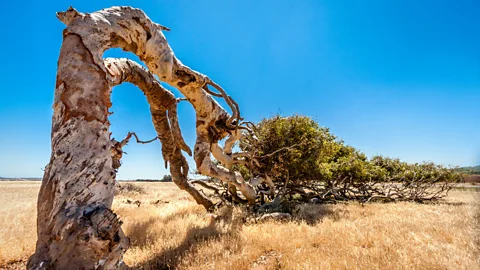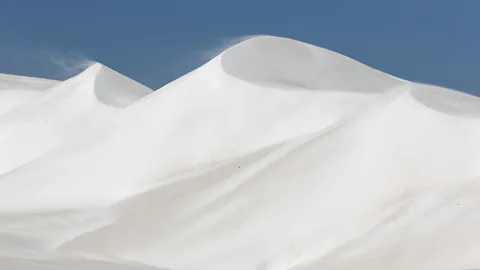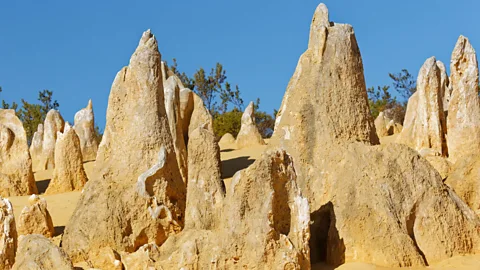An extraordinary landscape at the edge of the world
 Jean-Bernard Carillet
Jean-Bernard CarilletAustralia is known worldwide for some truly distinctive rock formations. But there are few more remarkable than the eerie and astounding Pinnacles Desert.
The star turn driving up the long, lonely Indian Ocean Drive north of Perth was not the sparkling ribbon of ocean that hugged the road to the left or the flawlessly blue sky that stretched endlessly into the horizon. It was not the lemon-scented gums that sent dappled light onto the scorching asphalt and left a waft of citrus, nor, as we got further north, the scrubby bush that popped with orange-coned banksia flowers.
On this sunny Saturday that was yet another perfect day in Western Australia, what captured my imagination was something far more incongruous: thousands of huge limestone pillars rising from a stark landscape of yellow sand.
Australia is known worldwide for some truly distinctive rock formations. But there are few more remarkable than the eerie and astounding Pinnacles Desert. And in a land where awe-inspiring geological features with peculiar names barely raise an eyebrow – think Uluru, the Bungle Bungles, Booroomba Rocks and the Tessellated Pavement – the Pinnacles must surely be, well, the pinnacle.
“It’s an incredibly special place. That limestone, the colours, the desert landscape; the fact you can get all of this so close to Perth is remarkable,” said Carola Verschuren, chief explorer at Explore Tours Perth. “I tell visitors it’s like we’re about to enter another planet.”
 Jean-Bernard Carillet
Jean-Bernard CarilletYou may also be interested in:
• The strange animal roaming Australia
I had decided to travel this far north of Perth – a 400km round trip in a single day – as I had heard about the strong, strange wind that pelts this coastline, creating an otherworldly landscape that few can imagine. I’d started my journey in the charmingly small state capital, where, as I’d walked up St George’s Terrace, one of the main thoroughfares, I’d been advised to hold onto my skirt. I’d laughed, as the day was still and calm; the cloudless sky showing no signs of turbulence. But then, suddenly, a gust howled up the street, the tall buildings on either side essentially creating a massive wind tunnel. I shrieked, firmly holding down my dress. This was my first encounter with what locals call “the Fremantle Doctor”.
“It’s the name that we give to the sea breeze. But at times it’s not a breeze; it’s not always a nice, gentle cooling beast, it can be an absolute monster in of the strength of it,” said Neil Bennett, media and communications manager at Western Australia’s Bureau of Meteorology. “Perth is the windiest city in Australia.”
The “Doctor”, as the wind’s name is lovingly shortened to, appears like clockwork each summer afternoon, caused by the temperature difference between the ocean and the land, according to Bennett. “That’s where the ‘Doctor’ term comes from: it’s the relief, that healing, from the heat. It just cools things down,” he said.
In fact, from immense heat to tropical cyclones to wind vortexes, Western Australia is home to all kinds of extreme weather events. The state holds the record for the strongest wind gust ever recorded (a mighty 408km/h, set in 1996 off the state’s north coast) – and it’s these blusters and gales that are partly responsible for its peculiar natural wonders.
 Steve Taylor ARPS/Alamy
Steve Taylor ARPS/AlamyI drove north up the coastal road, past wind farms to the tiny fishing town of Lancelin, which swells from its usual population of 700 to more than 2,000 each January when it hosts one of the best-known water sports championships in the world, the Lancelin Ocean Classic, which draws pro windsurfers, kite-surfers and ocean paddlers.
“People come to Lancelin from all over the world because the wind is so consistent here,” Bennett told me.
I could see the truth of that first hand. Low-rise houses were set next to trees growing at 45-degree angles, as though caught in a frozen scream trying to outrun the ferocious gusts. In the manicured park where kids played on skateboards and bikes, picnic benches and public barbecues were walled in on three sides as protection, only open on the eastern, inland edge. I could see incongruous three-storey-high dunes of pure-white sand, some of which had been blown far, far inland, several kilometres from the coastline, by the wind. “They’re known as ‘the mobile dunes’ as they’re moving at a rate of about 12m per year in a northerly direction, towards the Pinnacles,” Verschuren said. “There’s even signs on the road warning drivers of reduced visibility when the wind is that strong and blowing the sand off the coast.”
Adventurous tourists flock to these colossal dunes for four-wheel driving, quad biking and sandboarding – often combining their trip with a visit to the Pinnacles. But most won’t know that it’s this same sand, combined with the westerly wind, that created those thousands of rocky pillars just 50km further to the north.
 Jean-Bernard Carillet
Jean-Bernard CarilletLocated in the middle of Nambung National Park, the Pinnacles Desert is one of Australia's most extraordinary landscapes. Here, multitudes of huge limestone pillars reach as high as 4m tall, set against a backdrop of golden sand. As I walked between the jagged columns and mushroom-topped spires that stretched endlessly into the distance, the yellow limestone glowed under the fierce sun, highlighting coloured streaks of mineral sediment in the rock. It was almost as though an entire army had been turned to stone while standing guard over the coast and watching for invaders; a reminder, perhaps, of how the indigenous people would have watched European explorers and settlers arriving in ships from the west, wondering who they were and where they had come from.
In fact, this has long been a sacred place for the local indigenous people, and I felt a sense of awe and gratitude to be here. The scale of the place was massive. The handful of visitors, snapping selfies against the weathered rocks, looked like ants scurrying across the landscape. The place was so alien, so extraordinary (Roger Federer likened it to being on the Moon when he visited in late 2018), that it was hard for me to understand how it could even exist.
There are many theories as to how the Pinnacles were formed. Early explorers thought that they’d stumbled upon the ruins of a lost city, while others believed they were fossilised tree trunks. According to Professor Ken McNamara, adjunct professor in the School of Earth Sciences at the University of Western Australia, the truth is that they were formed around 120,000 years ago after the sea receded and left deposits of calcium-rich sea shells, or calcium carbonate, and quartz sand.
 Jean-Bernard Carillet
Jean-Bernard Carillet“They’re amazing, extreme examples of karstification,” he said, explaining that over tens of thousands of years, the westerly winds blew these deposits into high sand dunes along the coast, which eventually turned into limestone, eroded in parts and formed the Pinnacles.
Bennett agreed. “The shape of the Pinnacles has been formed by wind erosion; the consistent blowing of the wind that picks up loose particles of sand and that hammers against the rock formations, and that’s how the erosion occurred,” he said, adding, “It spooked me out completely. It’s a weird place.”
As I walked on the shifting sand, past emu footprints and sunning lizards to the Pinnacles Desert Lookout, the sun sunk lower in the sky, causing shadows to ripple across the sand and shifting the mood of the place to something more sombre. “You could come here every day for a year and take a photo each time, and every day it will be different. The light and shadows are amazing,” Verschuren said.
 Jean-Bernard Carillet
Jean-Bernard CarilletThe shapes and extent of the rock formations were incredible. Although it felt like I was walking through an ancient landscape, McNamara later told me that if you visit on a windy day, you can watch new pinnacles literally emerging in front your eyes.
“A little round bump appears in the sand, and you think ‘if I come back in a couple of years’ time and the wind’s been blowing, there’ll probably be a 2m- or 3m-high pinnacle there’,” he said, adding that the sand dunes at Lancelin are in fact the “most modern version” of the Pinnacles. “They’d likely need increased rainfall and some vegetation to stabilise them, as at the moment they’re mobile, but they could eventually turn into limestone. Come back in 10,000 or 20,000 years and have look,” he said, jokingly.
Although I was far from my Melbourne home and unlikely to come back any time soon, this eerie, otherworldly land had me captivated. As I left, the sun was falling into the sea, sending bolts of colour blazing across the sky, from reds to oranges to violets. The Indian Ocean stretched endlessly into the distance – there’s nothing west of here until you hit the southern tip of Africa – and I shivered as the wind blew in off the water, a final reminder of the Doctor’s power on this long, lonely stretch of coast.
more than three million BBC Travel fans by liking us on Facebook, or follow us on Twitter and Instagram.
If you liked this story, sign up for the weekly bbc.com features newsletter called "The Essential List". A handpicked selection of stories from BBC Future, Culture, Worklife and Travel, delivered to your inbox every Friday.
{"image":{"pid":""}}
